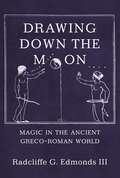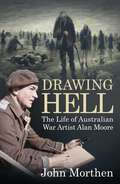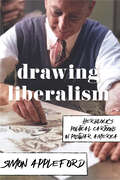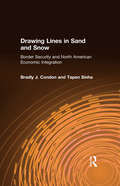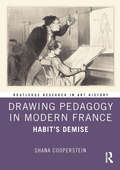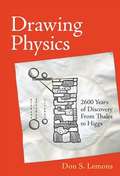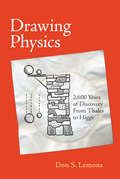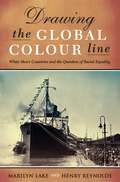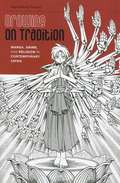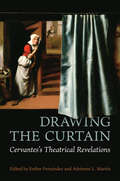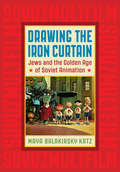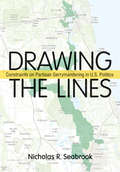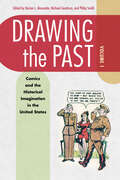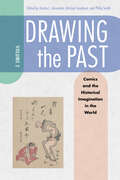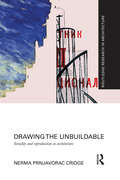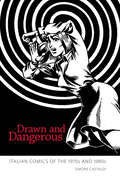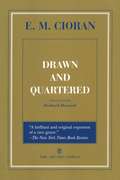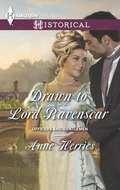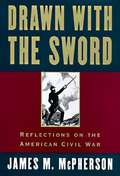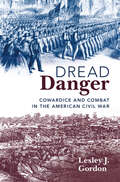- Table View
- List View
Drawing Down the Moon: Magic in the Ancient Greco-Roman World
by III Radcliffe G. Edmonds IIIAn unparalleled exploration of magic in the Greco-Roman worldWhat did magic mean to the people of ancient Greece and Rome? How did Greeks and Romans not only imagine what magic could do, but also use it to try to influence the world around them? In Drawing Down the Moon, Radcliffe Edmonds, one of the foremost experts on magic, religion, and the occult in the ancient world, provides the most comprehensive account of the varieties of phenomena labeled as magic in classical antiquity. Exploring why certain practices, images, and ideas were labeled as “magic” and set apart from “normal” kinds of practices, Edmonds gives insight into the shifting ideas of religion and the divine in the ancient past and in the later Western tradition.Using fresh approaches to the history of religions and the social contexts in which magic was exercised, Edmonds delves into the archaeological record and classical literary traditions to examine images of witches, ghosts, and demons as well as the fantastic powers of metamorphosis, erotic attraction, and reversals of nature, such as the famous trick of drawing down the moon. From prayer and divination to astrology and alchemy, Edmonds journeys through all manner of ancient magical rituals and paraphernalia—ancient tablets, spell books, bindings and curses, love charms and healing potions, and amulets and talismans. He considers the ways in which the Greco-Roman discourse of magic was formed amid the cultures of the ancient Mediterranean, including Egypt and the Near East.An investigation of the mystical and marvelous, Drawing Down the Moon offers an unparalleled record of the origins, nature, and functions of ancient magic.
Drawing Hell: The Life of War Artist - Alan Moore
by J P Morthen"From the sweltering battlefields of the South Pacific to the devastated cities of Europe, Alan Moore witnessed the greatest war in human history—not with a rifle, but with a paintbrush."As an official war artist with the RAAF, Moore was sent deep into the action, capturing history as it unfolded. He documented the brutal Japanese counterattack at Los Negros Island, the perilous missions of airmen dodging flak over Eastern Europe, and the harrowing reality inside one of Nazi Germany&’s most infamous concentration camps. With his camera, sketchbook, and oil paints, he recorded not just battles, but the human cost of war—the exhaustion, the fear, the destruction, and the small moments of resilience that defined a generation. Yet despite his remarkable body of work, Alan Moore remains one of Australia&’s forgotten artists. His paintings, raw and unfiltered, serve as powerful reminders of the horrors of war, ensuring that the sacrifices of those who served are never lost to history. Through meticulous research and rare archival materials, Drawing Hell unearths the story of a man whose work still hangs in some of the world&’s most prestigious museums and galleries. Moore&’s life spanned a century of conflict, change, and artistic evolution, yet his story has remained largely untold—until now. In this gripping account, historian John Morthen brings Moore&’s legacy back into the spotlight, revealing how his art shaped the way we remember war. For those who believe history should never be forgotten, Drawing Hell is an essential read.
Drawing Liberalism: Herblock’s Political Cartoons in Postwar America
by Simon ApplefordDrawing Liberalism is the first book-length critical examination of the political and social impact of the political cartoonist Herbert Block—popularly known as Herblock. Working for the Washington Post, Herblock played a central role in shaping, propagandizing, and defending the ideals of postwar liberalism, a normative set of values and assumptions that dominated American politics and culture after World War II.Best remembered for his unrelenting opposition to and skewering cartoons of Joseph McCarthy and Richard Nixon, Herblock introduced the term "McCarthyism" into the American political lexicon. With its unstinting and unapologetic support for the liberal agenda, across a career spanning over fifty years at the Post, Herblock’s work affords a unique lens through which to interpret and understand the shifts and contours of twentieth-century American political culture, from the postwar period through the civil rights era into the Nixon presidency.
Drawing Lines in Sand and Snow: Border Security and North American Economic Integration
by CondonThis important book addresses the major issues facing the North American continent: security, economic integration, border management, corruption, and illegal migration.
Drawing Outside the Lines: A Julia Morgan Novel
by Susan J. AustinMeet the brilliant, fearless, and ambitious Julia Morgan. In 1883, eleven-year-old Julia visits the amazing new Brooklyn Bridge—an experience that ignites within her a small but persistent flame. Someday, she decides, she too will build an astounding structure. Growing up in horse-and-buggy Oakland, Julia enjoys daring fence walks, climbing the tallest trees, and constantly testing her mother’s patience with her lack of interest in domestic duties and social events. At a time when “brainy” girls are the object of ridicule, Julia excels in school and consistently outsmarts her ornery brothers—but she has an even greater battle ahead. When she enrolls at university to study engineering, the male students taunt her, and the professors belittle her. Through it all, however, Julia holds on to her dream of becoming an architect. She faces each challenge head-on, firmly standing up to those who believe a woman’s place is in the home. Fortunately, the world has yet to meet anyone like the indomitable Miss Morgan. Drawing Outside the Lines is an imagined childhood of pioneering architect Julia Morgan, who left behind her an extraordinary legacy of creativity, beauty, and engineering marvels.
Drawing Pedagogy in Modern France: Habit’s Demise (Routledge Research in Art History)
by Shana CoopersteinThis study uncovers the plethora of new, innovative drawing strategies that shaped French visual arts at the height of France’s imperial power.Horace Lecoq de Boisbaudran, Eugene Guillaume, and Félix Ravaisson, among others, designed new drawing procedures that responded to leading concerns of modern art and the exigencies of modern life: landscape painting and picturesque tourism, industrial design, and the use of drawing as vehicles of knowledge production and in social control. From graphic regimes that were “purement mathématique” and demanded the practice of orthographic projection, to those that privileged the articulation of proportions and the cultivation of an internal measuring system, fin de siècle educators in the fine and applied arts radically transformed drawing strategies and its history. The shifting parameters of drawing pedagogy and practice unfold onto a wider set of theoretical concerns central to humanistic inquiry and art-making today: the philosophy and cultural history of habit-based learning, the relation between industrialization and drawing, and the relation between art and mathematics.The book will be of interest to scholars working in art history, French studies, history of art education, history of philosophy, and history of science.
Drawing Physics: 2,600 Years of Discovery From Thales to Higgs
by Don S. LemonsHumans have been trying to understand the physical universe since antiquity. Aristotle had one vision (the realm of the celestial spheres is perfect), and Einstein another (all motion is relativistic). More often than not, these different understandings begin with a simple drawing, a pre-mathematical picture of reality. Such drawings are a humble but effective tool of the physicist's craft, part of the tradition of thinking, teaching, and learning passed down through the centuries. This book uses drawings to help explain fifty-one key ideas of physics accessibly and engagingly. Don Lemons, a professor of physics and author of several physics books, pairs short, elegantly written essays with simple drawings that together convey important concepts from the history of physical science.Lemons proceeds chronologically, beginning with Thales' discovery of triangulation, the Pythagorean monocord, and Archimedes' explanation of balance. He continues through Leonardo's description of "earthshine" (the ghostly glow between the horns of a crescent moon), Kepler's laws of planetary motion, and Newton's cradle (suspended steel balls demonstrating by their collisions that for every action there is always an equal and opposite reaction). Reaching the twentieth and twenty-first centuries, Lemons explains the photoelectric effect, the hydrogen atom, general relativity, the global greenhouse effect, Higgs boson, and more. The essays place the science of the drawings in historical context -- describing, for example, Galileo's conflict with the Roman Catholic Church over his teaching that the sun is the center of the universe, the link between the discovery of electrical phenomena and the romanticism of William Wordsworth, and the shadow cast by the Great War over Einstein's discovery of relativity. Readers of Drawing Physics with little background in mathematics or physics will say, "Now I see, and now I understand."
Drawing Physics: 2,600 Years of Discovery from Thales to Higgs
by Don S. LemonsDrawings and short essays offer engaging and accessible explanations of key ideas in physics, from triangulation to relativity and beyond. Humans have been trying to understand the physical universe since antiquity. Aristotle had one vision (the realm of the celestial spheres is perfect), and Einstein another (all motion is relativistic). More often than not, these different understandings begin with a simple drawing, a pre-mathematical picture of reality. Such drawings are a humble but effective tool of the physicist's craft, part of the tradition of thinking, teaching, and learning passed down through the centuries. This book uses drawings to help explain fifty-one key ideas of physics accessibly and engagingly. Don Lemons, a professor of physics and author of several physics books, pairs short, elegantly written essays with simple drawings that together convey important concepts from the history of physical science. Lemons proceeds chronologically, beginning with Thales' discovery of triangulation, the Pythagorean monocord, and Archimedes' explanation of balance. He continues through Leonardo's description of “earthshine” (the ghostly glow between the horns of a crescent moon), Kepler's laws of planetary motion, and Newton's cradle (suspended steel balls demonstrating by their collisions that for every action there is always an equal and opposite reaction). Reaching the twentieth and twenty-first centuries, Lemons explains the photoelectric effect, the hydrogen atom, general relativity, the global greenhouse effect, Higgs boson, and more. The essays place the science of the drawings in historical context—describing, for example, Galileo's conflict with the Roman Catholic Church over his teaching that the sun is the center of the universe, the link between the discovery of electrical phenomena and the romanticism of William Wordsworth, and the shadow cast by the Great War over Einstein's discovery of relativity. Readers of Drawing Physics with little background in mathematics or physics will say, “Now I see, and now I understand.”
Drawing The Global Colour Line: White Men's Countries and the Question of Racial Equality
by Henry Reynolds Marilyn LakeAt last a history of Australia in its dynamic global context. In the late nineteenth and early twentieth centuries, in response to the mobilisation and mobility of colonial and coloured peoples around the world, self-styled 'white men's countries' in South Africa, North America and Australasia worked in solidarity to exclude those peoples they defined as not-white--including Africans, Chinese, Indians, Japanese and Pacific Islanders. Their policies provoked in turn a long international struggle for racial equality. Through a rich cast of characters that includes Alfred Deakin, WEB Du Bois, Mahatma Gandhi, Lowe Kong Meng, Tokutomi Soho, Jan Smuts and Theodore Roosevelt, leading Australian historians Marilyn Lake and Henry Reynolds tell a gripping story about the circulation of emotions and ideas, books and people in which Australia emerged as a pace-setter in the modern global politics of whiteness. The legacy of the White Australia policy still cases a shadow over relations with the peoples of Africa and Asia, but campaigns for racial equality have created new possibilities for a more just future. Remarkable for the breadth of its research and its engaging narrative, Drawing the Global Colour Line offers a new perspective on the history of human rights and provides compelling and original insight into the international political movements that shaped the twentieth century. Winner of the Ernest Scott Prize 2009 Winner of the Queensland Premier's Prize for History 2009 Winner of the Prime Minister's Prize for Non-Fiction 2009
Drawing in the Present Tense
by Claire Gilman Roger MalbertA richly illustrated, up-to-the-minute overview of new approaches in drawing, in the context of recent developments of other forms of contemporary art. Drawing in the Present Tense explores the variety of ways in which contemporary artists from around the world have come to approach drawing as the primary element of their practice. One which is autonomous: an end in itself, rather than a means to an end in another, more substantial medium. In an era of advanced technologies where image production has accelerated—potentially beyond the capacity of human attention—what values can be attributed to the slow, deliberate process of drawing by hand? The artworks featured in this volume are not confined to traditional tools; one can also draw on a computer, tablet, or smartphone, and examples of this are incorporated into the narrative as one mediumamong many. Sections are grouped thematically by specific approaches, including abstraction and figuration, nature and artifice, social observation and critique. With essays and spreads for each section, the book’s selection of seventy contemporary international artists of diverse backgrounds and experience includes not only recognizable names such as Michael Armitage, Camille Henrot, Robert Longo, Amy Sillman, and Kara Walker, but also a host of emerging talents. Beautifully presented in a visually appealing and tactile format with the feel of an artist’s portfolio, this is an inspiring overview of the best drawing practice today.
Drawing on Tradition: Manga, Anime, and Religion in Contemporary Japan
by Jolyon Baraka ThomasManga and anime (illustrated serial novels and animated films) are highly influential Japanese entertainment media that boast tremendous domestic consumption as well as worldwide distribution and an international audience. Drawing on Tradition examines religious aspects of the culture of manga and anime production and consumption through a methodological synthesis of narrative and visual analysis, history, and ethnography. Rather than merely describing the incidence of religions such as Buddhism or Shinto in these media, Jolyon Baraka Thomas shows that authors and audiences create and re-create "religious frames of mind" through their imaginative and ritualized interactions with illustrated worlds. Manga and anime therefore not only contribute to familiarity with traditional religious doctrines and imagery, but also allow authors, directors, and audiences to modify and elaborate upon such traditional tropes, sometimes creating hitherto unforeseen religious ideas and practices.
Drawing the Curtain: Cervantes's Theatrical Revelations (Toronto Iberic)
by Esther Fernández Adrienne L. MartínMiguel de Cervantes’s experimentation with theatricality is frequently tied to the notion of revelation and disclosure of hidden truths. Drawing the Curtain showcases the elements of theatricality that characterize Cervantes’s prose and analyses the ways in which he uses theatricality in his own literary production. Bringing together the works of well-known scholars, who draw from a variety of disciplines and theoretical approaches, this collection demonstrates how Cervantes exploits revelation and disclosure to create dynamic dramatic moments that surprise and engage observers and readers. Hewing closely to Peter Brook’s notion of the bare or empty stage, Esther Fernández and Adrienne L. Martín argue that Cervantes’s omnipresent concern with theatricality manifests not only in his drama but also in the myriad metatheatrical instances dispersed throughout his prose works. In doing so, Drawing the Curtain sheds light on the ways in which Cervantes forces his readers to engage with themes that are central to his life and works, including love, freedom, truth, confinement, and otherness.
Drawing the Iron Curtain: Jews and the Golden Age of Soviet Animation
by Maya Balakirsky KatzIn the American imagination, the Soviet Union was a drab cultural wasteland, a place where playful creative work and individualism was heavily regulated and censored. Yet despite state control, some cultural industries flourished in the Soviet era, including animation. Drawing the Iron Curtain tells the story of the golden age of Soviet animation and the Jewish artists who enabled it to thrive. Art historian Maya Balakirsky Katz reveals how the state-run animation studio Soyuzmultfilm brought together Jewish creative personnel from every corner of the Soviet Union and served as an unlikely haven for dissidents who were banned from working in other industries. Surveying a wide range of Soviet animation produced between 1919 and 1989, from cutting-edge art films like Tale of Tales to cartoons featuring "Soviet Mickey Mouse" Cheburashka, she finds that these works played a key role in articulating a cosmopolitan sensibility and a multicultural vision for the Soviet Union. Furthermore, she considers how Jewish filmmakers used animation to depict distinctive elements of their heritage and ethnic identity, whether producing films about the Holocaust or using fellow Jews as models for character drawings. Providing a copiously illustrated introduction to many of Soyuzmultfilm's key artistic achievements, while revealing the tumultuous social and political conditions in which these films were produced, Drawing the Iron Curtain has something to offer animation fans and students of Cold War history alike.
Drawing the Line: How Mason and Dixon Surveyed the Most Famous Border in America
by Edwin DansonThe second edition of Drawing the Line: How Mason and Dixon Surveyed the Most Famous Border in America updates Edwin Danson's definitive history of the creation of the Mason - Dixon Line to reflect new research and archival documents that have come to light in recent years. Features numerous updates and revisions reflecting new information that has come to light on surveyors Charles Mason and Jeremiah Dixon Reveals the true origin of the survey's starting point and the actual location of the surveyors' observatory in Embreeville Offers expanded information on Mason and Dixon's transit of Venus adventures, which would be an important influence on their future work, and on Mason's final years pursuing a share of the fabulous Longitude prize, and his death in Philadelphia Includes a new, more comprehensive appendix describing the surveying methods utilized to establish the Mason-Dixon Line
Drawing the Lines: Constraints on Partisan Gerrymandering in U.S. Politics
by Nicholas R. SeabrookRadical redistricting plans, such as that pushed through by Texas governor Rick Perry in 2003, are frequently used for partisan purposes. Perry's plan sent twenty-one Republicans (and only eleven Democrats) to Congress in the 2004 elections. Such heavy-handed tactics strike many as contrary to basic democratic principles. In Drawing the Lines, Nicholas R. Seabrook uses a combination of political science methods and legal studies insights to investigate the effects of redistricting on U.S. House elections. He concludes that partisan gerrymandering poses far less of a threat to democratic accountability than conventional wisdom would suggest.Building on a large data set of the demographics of redrawn districts and subsequent congressional elections, Seabrook looks less at the who and how of gerrymandering and considers more closely the practical effects of partisan redistricting plans. He finds that the redrawing of districts often results in no detrimental effect for district-level competition. Short-term benefits in terms of capturing seats are sometimes achieved but long-term results are uncertain. By focusing on the end results rather than on the motivations of political actors, Seabrook seeks to recast the political debate about the importance of partisanship. He supports institutionalizing metrics for competitiveness that would prove more threatening to all incumbents no matter their party affiliation.
Drawing the Past, Volume 1: Comics and the Historical Imagination in the United States
by Dorian L. Alexander, Michael Goodrum and Philip SmithContributions by Lawrence Abrams, Dorian L. Alexander, Max Bledstein, Peter Cullen Bryan, Stephen Connor, Matthew J. Costello, Martin Flanagan, Michael Fuchs, Michael Goodrum, Bridget Keown, Kaleb Knoblach, Christina M. Knopf, Martin Lund, Jordan Newton, Stefan Rabitsch, Maryanne Rhett, and Philip SmithHistory has always been a matter of arranging evidence into a narrative, but the public debate over the meanings we attach to a given history can seem particularly acute in our current age. Like all artistic mediums, comics possess the power to mold history into shapes that serve its prospective audience and creator both. It makes sense, then, that history, no stranger to the creation of hagiographies, particularly in the service of nationalism and other political ideologies, is so easily summoned to the panelled page. Comics, like statues, museums, and other vehicles for historical narrative, make both monsters and heroes of men while fueling combative beliefs in personal versions of United States history.Drawing the Past, Volume 1: Comics and the Historical Imagination in the United States, the first book in a two-volume series, provides a map of current approaches to comics and their engagement with historical representation. The first section of the book on history and form explores the existence, shape, and influence of comics as a medium. The second section concerns the question of trauma, understood both as individual traumas that can shape the relationship between the narrator and object, and historical traumas that invite a reassessment of existing social, economic, and cultural assumptions. The final section on mythic histories delves into ways in which comics add to the mythology of the US.Together, both volumes bring together a range of different approaches to diverse material and feature remarkable scholars from all over the world.
Drawing the Past, Volume 2: Comics and the Historical Imagination in the World
by Dorian L. Alexander, Michael Goodrum and Philip SmithContributions by Dorian L. Alexander, Chris Bishop, David Budgen, Lewis Call, Lillian Céspedes González, Dominic Davies, Sean Eedy, Adam Fotos, Michael Goodrum, Simon Gough, David Hitchcock, Robert Hutton, Iain A. MacInnes, Małgorzata Olsza, Philip Smith, Edward Still, and Jing Zhang In Drawing the Past, Volume 2: Comics and the Historical Imagination in the World, contributors seek to examine the many ways in which history worldwide has been explored and (re)represented through comics and how history is a complex construction of imagination, reality, and manipulation. Through a close analysis of such works as V for Vendetta, Maus, and Persepolis, this volume contends that comics are a form of mediation between sources (both primary and secondary) and the reader. Historical comics are not drawn from memory but offer a nonliteral interpretation of an object (re)constructed in the creator’s mind. Indeed, when it comes to history, stretching the limits of the imagination only serves to aid in our understanding of the past and, through that understanding, shape ourselves and our futures. This volume, the second in a two-volume series, is divided into three sections: History and Form, Historical Trauma, and Mythic Histories. The first section considers the relationship between history and the comic book form. The second section engages academic scholarship on comics that has recurring interest in the representation of war and trauma. The final section looks at mythic histories that consciously play with events that did not occur but nonetheless inflect our understanding of history. Contributors to the volume also explore questions of diversity and relationality, addressing differences between nations and the cultural, historical, and economic threads that bind them together, however loosely, and however much those bonds might chafe.Together, both volumes bring together a range of different approaches to diverse material and feature remarkable scholars from all over the world.
Drawing the Unbuildable: Seriality and Reproduction in Architecture (Routledge Research in Architecture)
by Nerma CridgeArchitecture is conventionally seen as being synonymous with building. In contrast, this book introduces and defines a new category - the unbuildable. The unbuildable involves projects that are not just unbuilt, but cannot be built. This distinct form of architectural project has an important and often surprising role in architectural discourse, working not in opposition to the buildable, but frequently complementing it. Using well-known examples of early Soviet architecture – Tatlin’s Tower in particular – Nerma Cridge demonstrates the relevance of the unbuildable, how it relates to current notions of seriality, copying and reproduction, and its implications for contemporary practice and discourse in the computational age. At the same time it offers a fresh view of our preconceptions and expectations of early Soviet architecture and the Constructivist Movement.
Drawn and Dangerous: Italian Comics of the 1970s and 1980s
by Simone CastaldiExploring an overlooked era of Italian history roiled by domestic terrorism, political assassination, and student protests, Drawn and Dangerous: Italian Comics of the 1970s and 1980s shines a new light on what was a dark decade, but an unexpectedly prolific and innovative period among artists of comics intended for adults. Blurring the lines between high art and popular consumption, artists of the Italian comics scene went beyond passively documenting history and began actively shaping it through the creation of fictional worlds where history, cultural data, and pop-realism interacted freely. Featuring brutal Stalinist supermen, gay space travelers, suburban juvenile delinquents, and student activists turned tech-savvy saboteurs, these comics ultimately revealed a volatile era more precisely than any mainstream press. Italian comics developed a journalistic, ideology-free, and sardonic approach in representing the key events of their times. Drawn and Dangerous makes a case for the importance of the adult comics of the '70s and '80s. During those years, comic production reached its peak in maturity, complexity, and wealth of cultural references. The comic artists' analyses of the political and religious landscape reveal fresh perspectives on a transformative period in Italian history.
Drawn and Quartered
by E. M. Cioran Eugene ThackerIn this collection of aphorisms and short essays, E.M. Cioran sets about the task of peeling off the layers of false realities with which society masks the truth. For him, real hope lies in this task, and thus, while he perceives the world darkly, he refuses to give in to despair. He hits upon this ultimate truth by developing his notion of human history and events as "a procession of delusions," striking out at the so-called "Fallacies of Hope." By examining the relationship between truth and action and between absolutes, unknowables, and frauds, Cioran comes out, for once, in favor of being.
Drawn to Lord Ravenscar
by Anne HerriesBETRAYED BY MARRIAGE When her betrothed is brutally murdered Lucy Dawlish looks for comfort from the man who shares her grief-his brother, Paul Ravenscar. Virtuous Lucy has always been secretly drawn to this frosty lord, but is it too late to reveal where her heart truly lies? Paul Ravenscar must marry and produce an heir for the sake of his estate, but there is only one woman he wants. To claim Lucy as his bride risks betraying his brother's memory, but Paul might be unable to keep his feelings hidden.... Officers and Gentlemen For duty, for honor, for love
Drawn to the Marquess (Imperfect Lords #2)
by Bronwen EvansDestined to go blind, a rake sets his sights on the toast of society, lighting a fire of passion that scorches the night, in this captivating novel from USA Today bestselling author Bronwen Evans. Stephen Hornsby, the Marquess of Clevedon, has one goal: to see every exquisite thing he can before he goes blind. His greatest joy, watching a woman shuddering in the throes of passion, will be gone. But before the darkness descends, he is determined to seduce a magnificent widow, Lady Penelope Fisherton. Unfortunately, his rakish reputation has preceded him; Lady Penelope spurns his advances. Being a man who relishes a challenge, however, her reluctance adds only luster to his desire for the last beautiful sight he’ll ever see. Considered the belle of London society, Lady Penelope was married to a scoundrel who cared for no one but himself. Now that she’s free, she wants nothing to do with love, passion, or desire—emotions that abandoned her with a cruel husband. So why does her body react when Stephen smiles? As much as she’d like to avoid the rogue, her brother-in-law wants her fortune, and he’ll kill to get it. Stephen is willing to help, but he’ll take only one thing in return: Her. In his bed.Advance praise for Drawn to the Marquess“Beautifully done! Drawn to the Marquess is a moving, touching romance of two people who prove to be exactly what each other needs at exactly the right time. I fell in love with Penelope and Stephen!”—New York Times bestselling author Jennifer Ashley“Brimming with passion, intrigue, and tenderness, Bronwen Evans’s latest is spectacular! A perfectly brilliant page-turning romance.”—USA Today bestselling author Collette Cameron“Drawn to the Marquess will captivate and seduce you. Bronwen Evans is a gem in Regency romance.”—Internationally bestselling author Tracy Goodwin“Passion. Intrigue. Saucy banter. Bronwen Evans has penned another must-read romance that gives the perfect hot peek into the Regency era. I couldn’t put this scorching page-turner down!”—Maeve Greyson, author of the Highland Protector series Look for the enchanting Disgraced Lords series from Bronwen Evans: A KISS OF LIES | A PROMISE OF MORE | A TOUCH OF PASSION | A WHISPER OF DESIRE | A TASTE OF SEDUCTION | A NIGHT OF FOREVER And don’t miss her novels in the Imperfect Lords series: ADDICTED TO THE DUKE | DRAWN TO THE MARQUESS Includes an excerpt from another Loveswept title.
Drawn with the Sword: Reflections on the American Civil War
by James M. Mcpherson'Drawn with the Sword' offers a series of thoughtful and engaging essays on some of the most enduring questions of the Civil War. The book is filled with fresh interpretations that punctures old myths and challenges new ones.
Draycott Everlasting: Christmas Knight & Moonrise
by Christina SkyeLove transcends time in a fan-favorite classic and a darkly seductive tale set at Draycott Abbey—from the New York Times–bestselling author.Christmas KnightAs Christmas approaches, Hope O’Hara is in desperate straits: unless she can find paying guests for the house she has lovingly restored, she’ll lose it to creditors. Enter one literal knight in shining armor—valiant and virile Ronan MacLeod, who is swept seven hundred years through time to save Hope from a potentially fatal accident . . . and to discover a passion for the ages.MoonriseDevastated by a colleague’s death and drawn to a thirteenth-century mystery, FBI agent Sara Nightingale arrives at Draycott Abbey for research and a much-needed getaway. Only, there she meets Navarre, a warrior from the Crusades who has been sent forth to avenge the guardian ghost of the abbey. Navarre and Sara cannot deny the centuries-old connection they feel . . . or the danger that surfaces from both the past and the present.Praise for Christina Skye and the Draycott Abbey series“Fast-paced action, vivid detail, a touch of the paranormal, and hot lovemaking will please readers of adventure romance, while fans of Skye’s Draycott Abbey and Code Name series will enjoy this clever union of the two.” —Booklist on To Catch a Thief“Christina Skye’s delightfully haunting Draycott Abbey tales . . . pass the test of time, as they remain some of the better romantic fantasies available.” —Harriet Klausner
Dread Danger: Cowardice and Combat in the American Civil War
by Lesley J. GordonWhen confronted with the abject fear of going into battle, Civil War soldiers were expected to overcome the dread of the oncoming danger with feats of courage and victory on the battlefield. The Fire Zouaves and the 2nd Texas Infantry went to war with high expectations that they would perform bravely; they had famed commanders and enthusiastic community support. How could they possibly fail? Yet falter they did, facing humiliating charges of cowardice thereafter that cast a lingering shadow on the two regiments, despite their best efforts at redemption. By the end of the war, however, these charges were largely forgotten, replaced with the jingoistic rhetoric of martial heroism, a legacy that led many, including historians, to insist that all Civil War soldiers were heroes. Dread Danger creates a fuller understanding of the soldier experience and the overall costs and sufferings of war.
